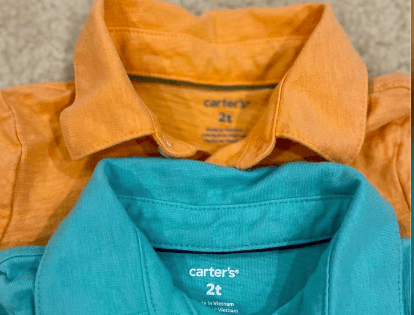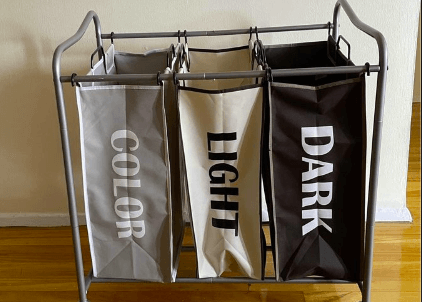Laundry piles up fast, especially when you have toddlers in your home, and it might be tempting to shove all of them into the washer and just hit start.
However, you’re good to go with a few simple tricks on how to separate laundry.
How To Sort Laundry
There are easier and better ways to clean your laundry without throwing everything in the washing machine, and one of such is knowing how to sort and separate your laundry.
In sorting your laundry, there are tips to get fresh and clean clothes out of every load, which can help protect your clothing from damage and make for better and more efficient washing.
There are two ways to separate your laundry piles, and they are:
1. Categorizing laundry items, and
2. Streamlining your laundry organization
Categorizing Laundry Items
In separating your laundry piles, you must pay close attention to details, checking and cross-checking each clothing or fabric to ensure that you do not make mistakes. Here is a simple guide for categorizing your laundry items.
Step 1: Check each item:
The first step to sorting a pile of laundry is to check each clothing item carefully, as it gives you a chance to make sure that every piece of clothing is where they belong so that a red sock doesn’t end up coloring your beautiful whites.
Checking them also involves reading the care label on each clothes, especially if you’re watching them for the first time.
Step 2: Separate by color

The next step to separating laundry by categorizing it is to sort the clothes by their colors. This can prevent color bleeding problems during washing that can ruin or damage white or lighter colored clothing.
To separate clothes by colors, follow these simple guidelines: make piles each for white, light, and dark clothing. Here’s a simple guide:
white pile: these can have cloth items like socks, underwear, t-shirts, and other sturdy white cotton items.
light-colored pile: these should have colors like pink, lavender, light blue, light green, and yellow, and the dark pile should have gray, black, navy, red, and purple articles.
Delicate pile: these piles should have knits, lingerie, or fabrics that require gentle washing
Cotton pile: these should have T-shirts, leggings, and cotton blends with more than 50 percent cotton
Polyester pile: these piles should have shirts, blouses, and poly-blends with more than 50 percent polyester
Denim and Jean’s pile: jean material, pants, khakis, and other heavy materials should be in this pile.
Athletic wear pile: these piles should have shorts, tanks, leggings, spandex, etc.
Towels and sheet piles: these should have towels, washcloths, hand towels, sheets, pillowcases, etc.
Note: These might seem like a lot of piles, but they are important when separating laundry so that you don’t have a stray red stick in a pile of white clothing.
Step 3: Sort by fabric weight And Type

One essential part of separating laundry is separating them based on their fabric type and weight; you don’t want to wash your heavy denim jacket with a silk fabric because the denim can damage the silk fabric.
Also, when separating laundry by weight and fabric type, you should think of things like shedding because some clothing items such as sweaters can be shed, so you want to be sure to wash them separately.
Step 4: Separate Soiled Clothes
Another category is to separate soiled clothes from those that aren’t soiled. So, if you have very soiled or stained clothes, you could put them in a separate pile altogether.
This is because these clothes may require pre-treating stains or washing on a specialty cycle that is too harsh for other articles.
Step 5: Wash New Clothes Separately
Most new clothes tend to bleed when washed for the first time due to leftover dye. So, new clothing, sheets, or towels should be washed separately, especially if they are bright or dark colors.
Streamlining Your Laundry Organization
Streamlining your laundry during sorting is an easy way out. Separation of laundry doesn’t have to be a long, boring chore; it can be easier and faster, and it all boils down to streamlining your laundry organization. Here is a guide for streamlining your laundry:
Strategize your sorting:
Strategizing your laundry involves creating a laundry routine. You could decide to sort your laundry pile while throwing them away before you do your laundry or sort them before you throw items in the washing machine.
Invest in a laundry sorter:

Getting a laundry sorter will make doing multiple loads of laundry a week easier and faster as this will speed up and simplify the sorting and washing processes.
Before getting a sorter, figure out how you’d like your laundries sorted. For example, you might items want a sorter with different sections for whites, lights, and darks.
Or, you could make your laundry sorter if you don’t want to spend money on a laundry sorter or divided hamper. You could create one for use around your home.
Homemade sorters are as effective as store-bought ones. The only difference is that you’d spend twice as less than what you could have spent buying one from a store because you would make use of items you have around the house such as boxes, shopping bags, or bins as hampers.
To make a home sorter yourself, you could purchase individual hampers at a home store around you and set them on the floor of your laundry room with an individual label for each hamper.
A second option is to buy separate hampers in different colors — white, a light shade, and a dark color. You could add one more for items that need immediate attention. These will help guide you and your family members, so you know exactly what items go in which hamper.
What To Look Out For When Sorting Laundry
When sorting is done properly, it saves time and energy. It won’t be boring. Everything comes together when sorting laundry, so here are a few things to look out for when separating your laundry below:
Clothing tags
It is important to check all clothing tags when sorting your laundry to determine how the clothes should be washed and dried. Aside from the mishap caused by color bleeding, washing a cloth wrongly could damage the clothing.
Check all pockets
It is best to always check the pockets of the clothes before sorting and then washing because failing to check pockets can leave you some nasty surprises, like lipstick, cell phones, important paperwork, or even money. These can also cause Laundry mishaps.
Check for sewing repairs
Checking to ensure that there are no loose threads, rips, button repairs, or other sewing repairs is not a bad idea. If you find any, you could repair them before washing the clothes because sometimes, washing the clothes with problems might only make them bigger.
Laundry Separation Tips and Tricks
Separating piles of laundry with the methods listed above isn’t difficult, and when done consistently, after a few times, you get used to it. However, the issue is when you get used to it, it might become a bore, but there are a few tips and tricks you can try to make things less boring and even easier.
Label baskets and hampers: you could label your laundry baskets or hampers by colors or fabric so that the whole family joins the laundry separation process; they could sort as they discard their soiled clothing.
Keep stain removal pre-treatments Close: Keeping stain removal pre-treatments close to the clothes baskets is important so that the items can be treated ahead of time. However, ensure to purchase a treatment that can sit for a few days.
Don’t throw bundles of clothes into the washer at once: try pulling each clothing item out from the laundry basket separately; it will help you find stray socks, underwear, and other items that were mistakenly put into the wrong basket.
Turn clothes inside: turning the clothes inside out will protect them when washing them. You can put delicates in a mesh bag to protect them and keep them together.
Keep the largest pile at the top of your laundry by washing them first before working your way down to the smallest.
Keep items you know will bleed, such as tie-dye shirts, out of the regular piles. Some clothes may have been washed several times, but their fabrics and dyes may continue to bleed for several wash cycles. So, it’s safer to be careful and prevent a laundry mishap than to try to remove the dye from your clothes.
